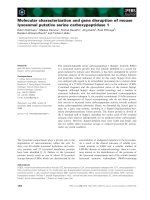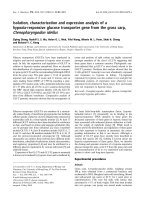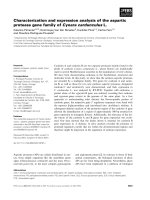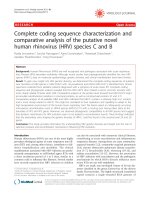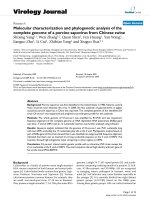Mitochondria coi-based molecular characterization and genetic analysis of the Fenazaquin selected resistant strain of two-spotted spider mite, Tetranychus Urticae Koch
Bạn đang xem bản rút gọn của tài liệu. Xem và tải ngay bản đầy đủ của tài liệu tại đây (569.07 KB, 10 trang )
Int.J.Curr.Microbiol.App.Sci (2019) 8(2): 2508-2517
International Journal of Current Microbiology and Applied Sciences
ISSN: 2319-7706 Volume 8 Number 02 (2019)
Journal homepage:
Original Research Article
/>
Mitochondria COI-Based Molecular Characterization and Genetic Analysis
of the Fenazaquin Selected Resistant Strain of Two-Spotted Spider Mite,
Tetranychus urticae Koch
Rakesh Kumar Sharma1*, Manmeet Brar Bhullar2 and Satnam Singh3
1
2
Dr D R Bhumbla RRS, Ballowal Saunkhri, Punjab, India
Department of Entomology, Punjab Agricultural University,
Ludhiana-141004, Punjab, India
3
RRS PAU, Faridkot, India
*Corresponding author
ABSTRACT
Keywords
Tetranychus
urticae, METI
acaricides,
Resistant, mt COI
Article Info
Accepted:
18 January 2019
Available Online:
10 February 2019
The two-spotted spider mite, Tetranychus urticae Koch (Acari: Tetranychidae) has
emerged as an important agricultural pest in a wide range of outdoor and protected crops
worldwide. Fenazaquin is METI-acaricide which is used extensively and frequently for the
management of this mite has resulted in the development of resistance. So, present studies
were conducted to investigate molecular characterization and genetic analysis based on
mtCOI sequence between fenazaquin resistant and susceptible population of T. urticae as
very limited information is available regarding mutation/variability in genes involved in
imparting resistance. Fenzaquin resistance population was developed in the laboratory by
giving selection pressure with fenazaquin for 15 generations leading to 166.49 fold
resistance when compared with susceptible population. Molecular characterization of
resistant and susceptible population revealed no changes in genes structure of mtCOI in the
resistant compared to the susceptible population. In our studies high level of resistance to
fenazaquin didn‟t show any change in the amino acid sequence of COI region of resistant
and susceptible populations Thus results revealed mtCOI as a stable gene which is least
influenced by acaricide resistance.
Introduction
The two-spotted spider mite, Tetranychus
urticae Koch (Acari: Tetranychidae) is an
important agricultural pest with a global
distribution and is one of the economically
most important pests in a wide range of
outdoor and protected crops worldwide
(Belay et al., 2018). This mite has a great
potential to produce high population which
depends particularly on temperature, humidity
and host plant and these in turn make it one of
the most important pests of greenhouses,
farms and orchards in different regions of the
world (Jeppson et al., 1975 and Zhang 2003.
It has been found that T. urticae has the
potential to quickly develop resistance to
almost all kinds of acaricides because of their
2508
Int.J.Curr.Microbiol.App.Sci (2019) 8(2): 2508-2517
high prolific rate, short life-cycle, high
reproductive
potential,
arrhenotokous
reproduction, polyphagous feeding habit,
coupled with their extremely dispersal
behavior (Stumpf et al., 2001; Croft et al.,
1988; Knowles et al., 1997 and
Ramasubramanian et al., 2005).
Mitochondrial electron transport inhibitors
(METI's) belong to a class of acaricides,
which are known to effectively control T.
urticae and other tetranychid mite species for
many years, including populations resistant to
other
chemical
classes
of
insecticides/acaricides. There are many
reports of acaricides becoming ineffective
against T. urticae after short period of their
use. TSSM or T. urticae has developed
resistance to many categories of acaricides
like organotins compounds, carbamates,
bifenthrin,
organophosphates,
dicofol,
abamectin,
METI
compounds
(like
fenazaquin, fenpyroximate, pyridaben etc.)
hexythiaziox, clofentezine and chlorfenapyr.
As a consequence, T. urticae has attained the
dubious reputation to be “the most resistant
species” in terms of the total number of
pesticides to which it has become resistant
(Van Leeuwan et al., 2010)
Fenazaquin attack a target-site in complex I
(NADH: ubiquinone oxidoreductase) of the
mitochondrial
respiratory
pathway
(Hollingworth et al., 1995). Resistance to
METIs has been reported in a number of
regions and crops (Sharma and Bhullar,
2018). The resistance of two-spotted spider
mite to METI-acaricides has already been
reported from many countries all over the
world, including Korea, England, Australia
and Belgium (Van Pottelberge et al., 2009,
Cho et al., 1995 and Herron et al., 1998)
Molecular approaches based on marker DNA
sequence comparison have been introduced as
tools for the identification of these species
(Vogler and Monaghan, 2007). Two
molecular markers, mitochondrial cytochrome
oxidase subunit I (mtCOI) and ribosomal
RNA internal transcribed spacer 2 (ITS2),
have been used extensively in the
classification of Tetranychidae mites (Navajas
et al., 1992). The mitochondrial gene coding
for the subunit I of the cytochrome oxidase
(mt COI) are commonly employed as
molecular markers and they have already
proved to be useful for separating distant
groups of individuals within an insect species
and resolving population genetic structures
(Behura, 2006).
Navajas et al (1998) reported that 5‟ end of
the mitochondrial COI gene is extensively
used as a barcode to identify Tetranychus
species and to analyze their phylogenetic
evolution. The control of T. urticae in Punjab
has been and still is largely based on the use
of acaricides. Fenazaquin is widely used for
control of T. urticae and other pests such as P.
ulmi on apple and citrus. The extensive and
frequent use of this acaricide facilitates
resistance development in some populations
of T. urticae in Punjab (Anonymous, 2018).
Molecular basis helps in better understanding
the development of resistance including
strategies to avoid resistance and to manage
spider mites when resistance is present. The
objectives of this research were molecular
analysis of resistant and susceptible
population of T. urticae for genetic
differences based on mtCOI.
Materials and Methods
Rearing of susceptible T. urticae population
The susceptible population of T. urticae was
maintained on brinjal without exposure to any
acaricide in the screen house and isolated
from possible contaminants (i.e. pesticides
and other arthropods for generations.
Fenazaquin (Magister) was used for resistance
2509
Int.J.Curr.Microbiol.App.Sci (2019) 8(2): 2508-2517
studies that act as Mitochondrial complex I
electron transport inhibitor.
Development
population
of
fenazaquin
resistant
The adult populations of T. urticae population
that was collected from Patiala exhibited
maximum
resistance
(24.65)
against
fenazaquin. Further resistance population was
developed as per protocol by Sharma et al.,
(2018). The acaricide resistant and susceptible
populations of T. urticae were used to assess
the genetic diversity in mtCOI.
Molecular characterization and genetic
analysis of resistant and susceptible T.
urticae populations
quality and by UV spectrophotometry for
concentrations. The resistant and susceptible
populations were investigated for molecular
differences using mitochondrial cytochrome
oxidase I (mtCOI) gene region, which has
been universally accepted as taxonomically
important' DNA barcode' region. Set of
primers specific to mtCOI region of T. urticae
were designed from the genome database
specific
to
mitochondrion
(http://
bioinformatics.psb.ugent.be/orcae/overview/
Tetur) of this organism and custom
synthesized
through
Integrated
DNA
Technologies, Inc, Coralville, IA, USA..
PAU_Acro 8204: TATCAACAAATCAT
AAAAATATTGG;
PAU_Acro
8912:
TATACTTCTGG ATGA CCAAAAAATCA
PCR amplification of mtCOI DNA
®
DNA was isolated using NucleoSpin Tissue
XS
(Macherey-Nagel-MN)
kitas
per
manufacturer‟s protocol, which Isolated was
analyzed by agarose gel electrophoresis for
PCR amplification of mtCOI from T.
urticaetotal DNA was carried out in a reaction
volume of 20 μL, which contained:
Component
Stock
concentration
Insect DNA
~20.0 ng/l
10.0 μM
F primer
10.0 μM
R primer
1.0 mM
dNTPs mix
5.0 units/μL
Taq polymerase
10X
Taq buffer (with 1.5mM MgCl2)
Sterile Milli-Q H2O to make 20 l PCR amplified products were resolved by
horizontal agarose gel electrophoresis using
1.0 per cent (w/v) agarose gel (supplemented
with ethidium bromide @ 1.0 mg/l) in 1X
TAE buffer. The agarose blocks containing
the specific amplified DNA band were cut
from the agarose gel with a clean, sharp
scalpel blade and transferred to a 1.5 μL
microcentrifuge tube and purified using
„QIAquick Gel Extraction Kit‟ (Qiagen) as
per manufacturer‟s protocol. The purified
DNA fragments were cloned into a „PCR
Volume (μL)
2.0
1.0
1.0
5.0
0.6
2.0
8.4
cloning vector‟ pGEM®-T Easy Vector
Systems (Promega) and transformed into
Escherichia coli JM109 host cells for mass
multiplication of plasmid. One hour grown
culture was spread (80-100μl) for selective
growth of transformants on LB-Amp-X-GALIPTG agar (LB agar supplemented with
ampicillin @ 100 μg. mL-1in Petri plates. The
Petri plates were incubated overnight at 37°C
for selection of the white recombinant clones
from individual bacterial isolates.
2510
Int.J.Curr.Microbiol.App.Sci (2019) 8(2): 2508-2517
Three individual recombinant (white) clones
from individual plates were picked up with a
sterile tooth pick, inoculated into culture tubes
containing 3 mL of LB-Ampicillin broth and
the tubes were incubated overnight at 37°C
under shaking conditions (180 rpm). Using
this broth culture, miniprep plasmids were
isolated using „alkaline lysis method‟. The
size of insert DNA, in different recombinant
plasmids
was
determined
by PCR
amplification using insert specific primer sets
(CO I) and universal M13 primers. The
recombinant plasmid was also double
restricted with restriction enzymes EcoR1 and
Pst1 (Fermentas Life Sciences) for further
confirmation of the insert. The sequencing
grade plasmid DNA was purified from the
respective recombinant clone using „Gene
Elute TMMiniprep Plasmid Kit‟ of „Sigma‟ as
per manufacturer‟s protocol. The clones were
sequencedthrough
Custom
Sequencing
Services of „M/S Eurofin Genomics,
Bangalore, India. The obtained sequences
were analysed using Megalin, SeqMan,
editSeq and Seqbuilder suits of lasergeneDNA star for nucleotide alignment amongst
individuals of resistant and susceptible
population. Any change in nucleotide
sequence in resistant population was
recorded.A
Results and Discussion
Development of fenazaquin
population of T. urticae
resistant
T. urticae population that was collected from
Patiala (exhibited maximum resistance of
24.65 fold against fenazaquin) was exposed to
serial concentrations, mortality was recorded
after 24 hrs and LC50 was determined and
selection pressure were applied unless there
was no further change in LC50 value. Finally,
the LC50 values were calculated for the F15
generation as there was not much change in
LC50 value and this population with 166.49
fold resistant was designated as fenazaquin
selected resistant population. The acaricide
resistant and susceptible populations of T.
urticae were used to assess molecular
mechanism of resistance.
Molecular Characterization of resistant
and susceptible populations of T.urticae
The T. urticae populations from PatialaPunjab have been compared with laboratory
maintained susceptible population from based
on mtCOI region.
Extraction and quantification of total DNA
from T. urticae adults from resistant and
susceptible population
The DNA was isolated from both resistant
and susceptible populations of T. urticae and
was run on 1.0 per cent agarose gel in TBE
buffer. A single condensed high molecular
weight band free from degradation was
obtained in from whole body tissues of both
susceptible and resistant populations (Fig. 1).
The DNA concentration as determined by
spectrophotometer ranged between 0.76µg/ µl
and 1.23µg/ µl. The quality of DNA was
determined by A260/A280 ratio which ranged
between 1.78 and 1.92 for two sample tissues
each of resistant and susceptible populations.
The gel electrophoresis, quantity and quality
revealed the good quality of DNA obtained
for subsequent molecular analysis of T.
urticae adult samples from resistant and
susceptible population.
Molecular characterization of resistant and
susceptible T. urticae populations- mtCOI
region
Mitocondrial COI region has gained global
importance and is being universally accepted
as taxonomically conserved region for insect
species and biotype/ strain identification.
Studies have suggested that high level of
acaricides/insecticide resistance may bring
about slight changes in nucleotide sequences
2511
Int.J.Curr.Microbiol.App.Sci (2019) 8(2): 2508-2517
of this mitochondrial DNA region (Maitra et
al., 2000, Catania et al., 2004 and Feyereisen,
2005). The specific primers were used to
amplify ~709bp DNA fragments of COI gene
from the mitochondrial DNA of both
susceptible and resistant population. Size of
these fragments was similar to the expected
size available in the NCBI database (NCBI,
1988) (www.ncbi.nlm.nih.gov). The single
clean amplified band supported the specificity
of desired region from both resistant and
susceptible populations (Fig. 2).
Custom sequencing of cloned COI DNA
fragments
The sequencing grade recombinant plasmid
(Fig. 3) from three different clones of COI
fragments from resistant and susceptible
variants were purified and sequenced
bidirectional through Eurofin Genomics Ltd,
Bangalore using M13 reverse and forward
primer. The raw sequence data was processed
using seqMan module of Lasergene DNA star
software for removing the vector sequences
and making a single sequence contig from the
respective sequences of resistant or
susceptible populations. The individual clones
as well as both the complimentary DNA
strands were proof read for any misread bases
by comparison with chromatograms of
original sequence (Fig. 4). The whole
sequence of each individual strand was
completed by aligning the sequence of one
strand with that of the reverse complimentary
sequence to yield a single sequence contig.
The final contigs from the respective
population were aligned to form a single
sequence in seqMan which was translated
using seqBuilder module of Lasergene- DNA
star. The mtCOI region sequence from
susceptible and resistant populations was
submitted to “GenBank Database” using
Banklt. The GenBank accession number
assigned to COI sequence from both the
submitted sequences are MF152824 and
MF152825.
Multiple alignment of COI nucleotide
sequence and derived amino acid sequence
Multiple alignment of COI nucleotide
sequence for both the resistant and susceptible
population of T. urticae established existence
of codon substitution at nucleotide position at
177, 444, 580 and 687 represented by
substitution with G,T, A and T, respectively
in resistant population compared to
susceptible population (Fig. 5).
The codon substitution however didn‟t result
in any change in the predicted amino acid
sequence of both resistant and susceptible
population consequently no change in the
protein has been observed (Fig. 6). The
mtCOI region of mitochondrial DNA is
highly conserved and has been globally
accepted as the gene of taxonomic
importance. This fragment has been widely
used for the identification of T. urticae
species as well. The usefulness of the COI
region for delineating tetranychid species has
been investigated in several studies
(Hinomoto et al., 2001, Hinomoto and
Takafuji., 2001, Navajas et al., 1994, 1996a,
1996b, 1998, Toda et al., 2000 and Xie et al.,
2006a). Recently, a DNA barcoding approach
was used to identify tetranychid species
(Hinomoto et al., 2007). Partial COI sequence
of 1257 nucleotides amplified and sequenced
in ten T. urticae strains identified all strains as
T. urticae when compared with available COI
sequences in public databases (NCBI). The
709 bp sequences of mtCOI region of
susceptible and resistant population showed
no significant differences in nucleotides.
2512
Int.J.Curr.Microbiol.App.Sci (2019) 8(2): 2508-2517
Fig.1 Total DNA isolated from fifty T. urticae female adults. 2µl of each DNA sample was
loaded in 1 % Agarose ETBR Gel (Susceptible-S1, S2, S3 and resistant- R1, R2, R3 population)
Fig.2 e PCR amplification of mt COI region (709bp) with mt COI specific primer set Custom
sequencing of cloned mtCOI DNA fragments
Fig.3 Sequencing grade plasmid on 1 % agrose gel for quality check prior to sequencing
2513
Int.J.Curr.Microbiol.App.Sci (2019) 8(2): 2508-2517
Fig.4 Comparative analysis of the two similar sequences from different clones using
chromatogram
Fig.5 Multiple alignment of COI nucleotide sequence of resistant and susceptible
populations of T. urticae
2514
Int.J.Curr.Microbiol.App.Sci (2019) 8(2): 2508-2517
Fig.6 Derived amino acid sequences of COI region variants of T. urticae
So the consensus sequence of their alignment
was blasted in NCBI database and this showed
high level of similarity with the existing COI
sequences. The low to moderate level of
resistance in the selected population has not
shown any change in the amino acid sequences
and thus no change in the protein structure.
Navajas et al., (1998) and Xie et al., (2006b)
while characterizing ten different strains based
on COI region, detected a total of six
haplotypes which showed no insertions or
deletions in the sequenced region. The COI
region has been almost widely accepted for
barcoding animals because of its generally
conserved priming sites. Moreover the
evolution of this gene is rapid enough to allow
the discrimination of not only closely allied
species, but also phylogeographic groups within
a single species (Cox and Herbert, 2001, Wares
and Cunningham, 2001). When looking at the
genetic distance between strains expressed as
nucleotide divergence of COI sequence, there
was no correlation between COI polymorphism,
geographical location of sampling and
resistance status. Thus most of the studies have
reported COI as a stable gene which is least
influenced by insecticide/ acaricide resistance.
In our studies high level of resistance to
fenazaquin didn‟t show any change in the
amino acid sequence of COI region of resistant
and susceptible populations.
Acknowledgement
Authors are thankful to the Indian Council of
Agricultural research, New Delhi (All India
Network Project on Agricultural Acarology),
for the financial assistance and to the Punjab
Agricultural University, Ludhiana for providing
the necessary research facilities.
References
Anonymous. 2013. Progress Report 2011-13.
All India Network Project on Agricultural
Acarology, UAS, GKVK, Bangalore.
Behura, S. K. 2006. Molecular marker systems
in insects: current trends and future
avenues. Molecular Ecology. 15: 3087 –
3113
Belay, T., Goftishu, M and Kassaye, A. 2018.
Management of an emerging pest,
Tetranychus urticae Koch (Acari:
Tetranychidae), with pesticides in Eastern
Ethiopia. African Crop Science Journal.
26: 291 - 304
Catania, F., Kauer, M. O., Daborn, P. J., Yen, J.
L., Ffrench-Constant, R. H and
Schlotterer, C.2004. World-wide survey
of an Accord insertion and its association
with DDT resistance in Drosophila
melanogaster. Mol Ecol. 13:2491–2504.
Cho, J. R., Kim, Y. J., Ahn, Y. J., Yoo, J. K and
Lee, J. O. 1995. Monitoring of acaricide
resistance in field collected populations of
Tetranychus
urticae
(Acari:
Tetranychidae) in Korea. Korean J Appl
Entomol. 31: 40-45.
Citation: Cazaux, M., Navarro, M., Bruinsma,
K.A., Zhurov, V., Negrave, T., Van
Leeuwen, T., Grbic, V., Grbic, M.
Application of Two-spotted Spider
2515
Int.J.Curr.Microbiol.App.Sci (2019) 8(2): 2508-2517
Citation: Cazaux, M., Navarro, M., Bruinsma,
K.A., Zhurov, V., Negrave, T., Van
Leeuwen, T., Grbic, V., Grbic, M.
Application of Two-spotted Spider
Citation: Cazaux, M., Navarro, M., Bruinsma,
K.A., Zhurov, V., Negrave, T., Van
Leeuwen, T., Grbic, V., Grbic, M.
Application of Two-spotted Spider
Cox, A. J and Hebert, P. D. N. 2001.
Colonization,
extinction
and
phylogeographic
patterning
in
a
freshwater crustacean. Mol. Ecol. 10:
371–386.
Croft, B. A and Van, H. E. 1988. Ecological
and genetic factors influencing evolution
of pesticide resistance in tetranychid and
phytoseeid mites. Exp Appl Acarol. 4:
277-300.
Dhar, T., Dey, P. K and Sarkar, P. K. 2000.
Influence of abiotic factors on population
build-up of red spider mite, Tetranychus
urticae on okra vis a vis evaluation of
some new pesticides for their control.
Pestology. 24: 34-37.
Feyereisen, R. 2005. Insect cytochrome P450,
In: Gilbert L I, Latrou K and Gill S S
(Eds.) Comprehensive Insect Physiology,
Biochemistry,
Pharmacology
and
Molecular Biology, Elsevier, Amsterdam.
Pp. 1-77.
Herron, G. A and Rophail, J. 1998.
Tebufenpyrad
(Pyranica)
resistance
detected in two-spotted spider mite
Tetranychus urticae Koch (Acari:
Tetranychidae) from apples in Western
Australia. Exp Appl Acarol. 22: 633-41.
Hinomoto, N and Takafuji, A. 2001. Genetic
diversity and phylogeny of the Kanzawa
spider mite, Tetranychus kanzawai, in
Japan. Exp Appl Acarol. 25: 355-70.
Hinomoto, N., Osakabe, M., Gotoh, T and
Takafuji, A. 2001. Phylogenetic analysis
of green and red forms of the two-spotted
spider mite, Tetranychus urticae Koch
(Acari: Tetranychidae), in Japan, based
on mitochondrial cytochrome oxidase
subunit I sequences. Appl Entomol Zool.
36: 459-64.
Hinomoto, N., Tran, D. P., Pham, A. T., Le,
T.B.N., Tajima, R., Ohashi, K., Osakabe,
M and Takafuji, A. 2007. Identification of
spider mites (Acari: Tetranychidae) by
DNA sequences: a case study in Northern
Vietnam. Int J Acarol. 33: 53-60.
Hollingworth, R. M and Ahammadsahib, K. I.
1995. Inhibitors of respiratory complex 1:
mechanisms, pesticidal actions and
toxicology. Rev Pestic Toxicol. 3: 277302.
Jeppson, L. R., Keifer, H. H and Baker, E. W.
1975. Mites injurious to economic plants,
Univ. Calf. Press. 614.
Knowles, C. O. 1997. Mechanisms of resistance
to acaricides. In: Sjut V (ed) Molecular
mechanisms
of
resistance
to
agrochemicals, Berlin: Springer Verlag.
13: 57–77.
Maitra, S., Dombrowski, S. M., Basu, M.,
Raustol, O., Waters, L. C and Ganguly, R.
2000. Factors on the third chromosome
affect the level of CYP6A2 and CYP6A8
expression in Drosophila melanogaster.
Gene. 248: 147–56.
Mite Tetranychus urticae for Plant-pest
Interaction Studies. J. Vis. Exp. (89),
e51738, doi:10.3791/51738 (2014)
Mite Tetranychus urticae for Plant-pest
Interaction Studies. J. Vis. Exp. (89),
e51738, doi: 10.3791/51738 (2014)
Mite Tetranychus urticae for Plant-pest
Interaction Studies. J. Vis. Exp. (89),
e51738, doi:10.3791/51738 (2014)
Navajas, M., Cotton, D., Kreiter, S and
Gutierrez, J.1992. Molecular approach in
spider mites (Acari: Tetranychidae):
preliminary data on ribosomal DNA
sequences. Exp Appl Acarol. 15: 211–18.
Navajas, M., Fournier, D., Lagnel, J., Gutierrez,
J and Boursot, P. 1996a. Mitochondrial
COI sequences in mites: evidence for
variations in base composition. Insect Mol
Biol. 5: 281-85.
Navajas, M., Gutierrez, J., Bonato, O., Bolland,
H. R and Mapangoudivassa, S.1994.
Intraspecific diversity of the cassava
green mite Mononycellus progresivus
(Acari, Tetranychidae) using comparisons
of mitochondrial and nuclear ribosomal
2516
Int.J.Curr.Microbiol.App.Sci (2019) 8(2): 2508-2517
DNA-sequences and cross-breeding. Exp
Appl Acarol. 18: 351-60.
Navajas, M., Gutierrez, J., Lagnel, J and
Boursot, P. 1996b. Mitochondrial
cytochrome oxidase I in tetranychid
mites: a comparison between molecular
phylogeny and changes of morphological
and life history traits. Bull Entomol Res.
86: 407–17
Navajas, M., Lagnel, J., Gutierrez, J and
Boursot,
P.
1998.
Species-wide
homogeneity of nuclear ribosomal ITS2
sequences in the spider mite Tetranychus
urticae
contrasts
with
extensive
mitochondrial
COI
polymorphism.
Heredity. 80: 742–52.
Ramasubramanian, R., Ramaraju, K and
Regupathy, A.2005. Acaricide resistance
in Tetranychus urticae Koch (Acari:
Tetranychidae)-Global
Scenario.
J
Entomol. 2: 33-39.
Sharma, R. K and Bhullar, M. B. 2018. Status
of acaricide resistance in field collected
two-spotted spider mite, Tetranychus
urticae Koch from vegetable growing
areas of Punjab, India. Journal of
Entomology and Zoology Studies. 6:328332
Sharma, R. K., Bhullar, M. B., Singh, S and
Jindal, V. 2018. Molecular analysis of
fenazaquin selected resistant strain of
two-spotted spider mite, Tetranychus
urticae Koch. Indian Journal of
Biotechnology. 17: 602-610.
Stumpf, N and Nauen, R. 2001. Crossresistance, inheritance, and biochemistry
of mitochondrial electron transport
inhibitor-acaricide
resistance
in
Tetranychus
urticae
(acari:
tetranychidae). Econ Entomol. 94: 1577-
83.
Toda, S., Osakabe, M and Komazaki, S. 2000.
Interspecific diversity of mitochondrial
COI sequences in Japanese Panonychus
species (Acari: Tetranychidae). Exp Appl
Acarol. 24: 821-29.
Van Leeuwan, T. V., Dermauw, W., Tirry, L.,
Vontas, J and Tsagkarakou, A. 2010.
Acaricide resistance mechanisms in the
two spotted spider mite Tetranychus
urticae and other important Acri. Insect
Biochem Mol Biol. 40: 563-71.
Van Pottelberge, S., Van Leeuwen, T., Nauen,
R and Tirry, L. 2009. Resistance
mechanisms to mitochondrial electron
transport inhibitors in a field-collected
strain of Tetranychus urticae Koch
(Acari: Tetranychidae). Bull Entomol Res.
99:23-31.
Vogler, A. P and Monaghan, M. T. 2007.
Recent advances in DNA taxonomy. J
Zool Syst Evol Res. 45: 1–10.
Wares, J. P and Cunningham, C. W. 2001.
Phylogeography and historical ecology of
the North Atlantic intertidal. Evolution.
12: 2455–2469.
Xie, L., Hong, X. Y and Xue, X. F. 2006a.
Population genetic structure of the twospotted
spider
mite
(Acari:
Tetranychidae) from China. Ann Entomol
Soc Am. 99: 959-65.
Xie, L., Miao, H and Hong, X.Y. 2006b. The
two-spotted spider mite Tetranychus
urticae Koch and the carmine spider mite
Tetranychus cinnabarinus (Boisduval) in
China mixed in their Wolbachia
phylogenetic tree. Zootaxa. 1165: 33-46.
Zhang, Z. 2003. Mites of Greenhouses, CABI
Publishing Oxon, UK. 244.
How to cite this article:
Rakesh Kumar Sharma, Manmeet Brar Bhullar and Satnam Singh. 2019. Mitochondria COI-Based
Molecular Characterization and Genetic Analysis of the Fenazaquin Selected Resistant Strain of
Two-Spotted Spider Mite, Tetranychus urticae Koch. Int.J.Curr.Microbiol.App.Sci. 8(02): 25082517. doi: />
2517


